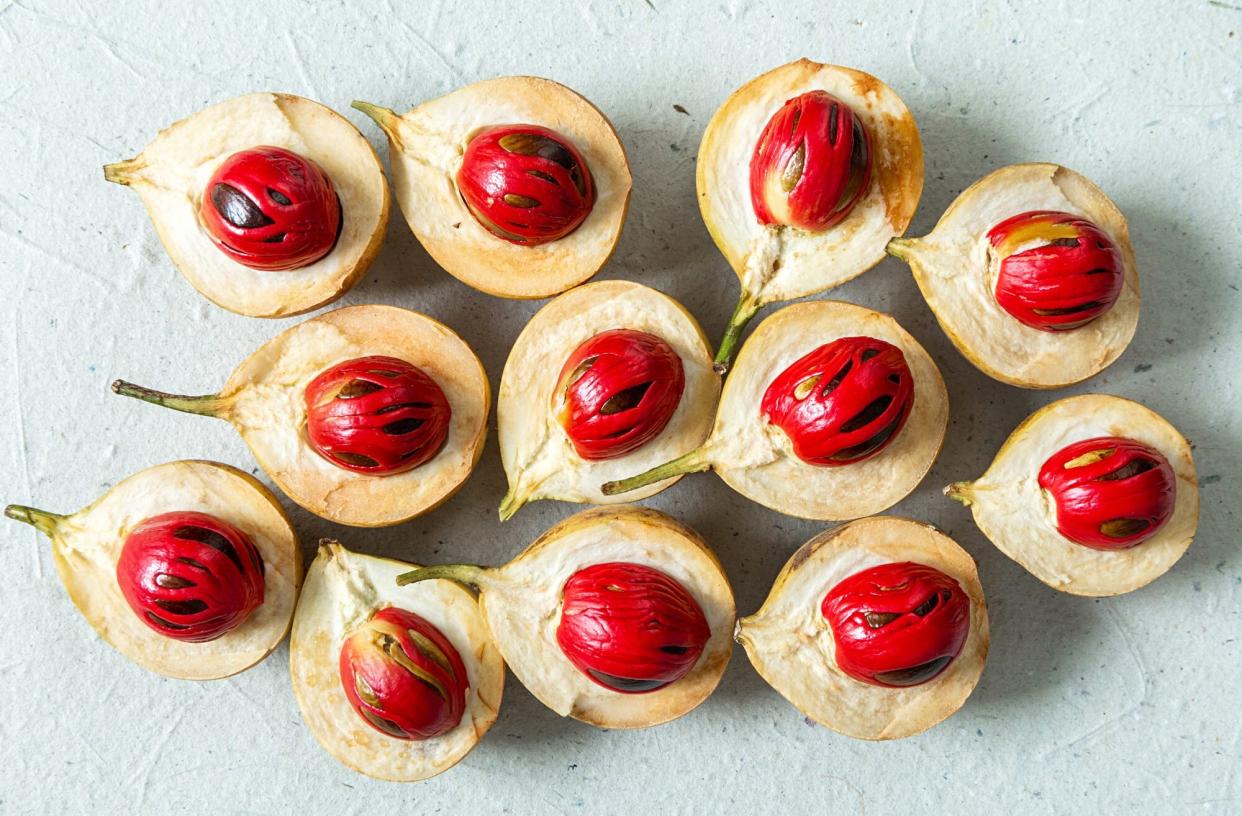There's More to Nutmeg Than Eggnog and Pumpkin Spice—Here's How to Use It Year Round

GETTY IMAGES
TABLE OF CONTENTS
On This Page
Sister Spices
Flavor Profiles
How to Use Nutmeg and Mace
History
Who hasn't sprinkled nutmeg on a cup of yuletide eggnog, or added a dash to pumpkin pie? While many home cooks associate the spice with holiday treats, those in the know embrace the complex flavors and luscious aromas of nutmeg—and its botanical sidekick, mace—just about any time of year.
Treasured since antiquity, nutmeg and mace were among the spices beloved by medieval European cooks. In the 1600s, the Dutch and Portuguese fought to control their nutmeg source—the Maluku Islands in Indonesia—fittingly dubbed the Spice Islands.
Two spice experts from family-owned organic nutmeg estates in Grenada, the world's second-largest producer of nutmeg (after Indonesia), share all there is to know about using these wondrous spices.
Related: The Right Way to Store Spices to Keep Them Fresh
One Tree, Two Spices
Nutmeg and mace are more than kissing cousins—these distinctive spices come from the same fruit-bearing evergreen tree, Myristica fragrans, indigenous to the tropical Banda Islands in Indonesia's Maluku region. Once the yellow fruit, called the nutmeg pericarp, matures, it splits into two to reveal a firm white interior and shiny nutmeg seed with a lace-like covering.
"It's really special that the seed provides two spices in one: the nutmeg and the beautiful bright red mace aril that envelops the seed," says Shadel Nyack Compton, managing director of Belmont Estate in St. Patrick, Grenada, West Indies. Belmont Estate has grown nutmeg since the 1800s and has been in Nyack Compton's family since her grandparents bought it in 1944. Today, the nutmeg is sustainably grown, harvested, dried, and packaged on the estate.
"In a way, the mace acts as the protective membrane between the fruit (pericarp) and the hard shell," adds Bobbie Garbutt, director of L'Esterre Estate, a 300-year-old plantation in St. Andrews, Grenada purchased by her grandparents in 1949. The property uses regenerative agricultural practices, implemented over the generations.
The ripe fruit is a spectacular sight. "It looks like a peach and hangs from the nutmeg tree like a Christmas ornament," says Nyack Compton. And indeed, it has gifts to share. Once ready for harvesting, the husk is removed and the nutmeg and mace are dried separately. "The fruit is not eaten fresh, but is used to make juices, jams or jellies, nutmeg syrup, nutmeg pickle, and other condiments and confectionaries," she says.
Nutmeg vs. Mace
Flavor Profiles
While nutmeg and mace have similar flavor profiles, there are marked differences, too. Mace packs a spicier, more intense wallop, so if replacing it for nutmeg in a recipe, you need just a quarter of the amount.
"Mace is often described as a unique flavor reminiscent of pepper and cinnamon combined," says Nyack Compton. "Nutmeg has a warm, nutty, and slightly sweet profile, with notes of mint, eucalyptus, cardamom, or pine. It has a more delicate and milder taste than mace."
Whole Seeds
Whole nutmeg seeds (which resemble walnuts) are much more potent than ground nutmeg. "They retain their flavor and fragrance most when whole," says Nyack Compton, adding that they should smell fragrant, with no mustiness.
She suggests using a microplane grater and grating just what's needed for a dish. The whole seeds (usually sold in batches of six to eight) can be stored for years in an airtight container in a cool, dry, dark place.
Ground Spice
Ground nutmeg keeps its fragrant properties for about nine months, says Nyack Compton. "Nutmeg starts losing its potency once it's grated because the oils start to oxidize, which holds a lot of the flavor," says Garbutt.
Mace is typically sold ground, but some specialty spice companies (like Burlap & Barrel, a customer of both farms) sell jars filled with pieces of the aril, called blades, which can be ground or crumbled into stews and rice dishes. Stored like nutmeg, both types of mace retain their flavor for about a year.
New Ways to Use Nutmeg and Mace
By all means, spruce up eggnog and pumpkin pies with nutmeg, but why not expand your horizons?
Mace enhances béchamel sauce, meat dishes, and savory creations, says Garbutt. She also adds it to homemade curry powder, pickled vegetables, fish pie, and sweet potatoes, to name a few favorites.
"Nutmeg in Grenada is mostly used in sweet desserts—we consume a lot of nutmeg ice cream!" says Garbutt. "It elevates any dairy product. I like mine finely grated over hot buttery toast—it adds another dimension you didn't realize was lacking before." She also uses nutmeg on overnight oats, muesli, plain yogurt, and rice pudding, and slides back to savory with stews, and any cheesy dish.
Both spices can be used extensively in flavoring and curing meats, says Nyack Compton. "Barbecue rubs, roasts, poultry breast, stewed lamb, and many other dishes are enhanced by the warm spicy flavor of nutmeg," she says.
Fascinating History
Nutmeg and mace were prized by ancient civilizations in India, China, and Arabia for their medicinal properties, thought to remedy headaches, flatulence, digestion, toothaches, and rheumatism. Nutmeg's fragrance also permeated the past: Emperor Henry VI had the streets of Rome fumigated with the spice before his coronation.
The Arabs were the first to make the culinary leap, and by the Middle Ages, European cooks lavished nutmeg, mace, and other spices, on meat, fish, desserts, wine, and nearly anything they could get their hands on. Nutmeg and mace also had an outsize impact on the global spice trade, fueling the Age of Exploration and playing a central role in the Spice Wars of the 1600s.
Though no longer trophies for world domination, nutmeg, and mace remain precious cargo, craved by cooks everywhere.

